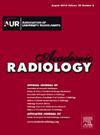比较三种基于超声波的技术对代谢功能障碍相关性脂肪肝的肝脏脂肪变性进行诊断和分级。
IF 3.8
2区 医学
Q1 RADIOLOGY, NUCLEAR MEDICINE & MEDICAL IMAGING
引用次数: 0
摘要
原理与目的以磁共振成像质子密度脂肪分数(PDFF)为金标准,比较超声衍生脂肪分数(UDFF)、受控衰减参数(CAP)和肝肾比(HRR)对代谢功能障碍相关性脂肪性肝病(MASLD)肝脂肪变性的诊断准确性和分级能力。方法将 2023 年 10 月至 2024 年 5 月期间在我院就诊的疑似 MASLD 患者分为 MASLD 组和对照组。所有患者均接受了 UDFF、CAP 和 PDFF 检查。在常规超声检查中测量了 HRR。在统计分析中,我们首先评估了 UDFF、CAP、HRR 和 PDFF 患者一般特征之间的相关性。随后,我们采用接收者操作特征曲线来评估和比较 UDFF、CAP 和 HRR 对 MASLD 不同等级肝脏脂肪变性的诊断性能。同时还确定了它们的曲线下面积、最佳临界值、灵敏度和特异性。最后,通过二元逻辑回归分析确定了确定 MASLD 肝脂肪变性(PDFF≥6%)的预测因素。UDFF、CAP和HRR均与PDFF呈正相关。其中,UDFF 与 PDFF 的相关性最强(ρ = 0.91)。此外,在不同等级肝脂肪变性的诊断效果比较中,UDFF 优于 CAP 和 HRR(P < 0.05)。然而,在所有三个等级中,CAP 和 HRR 的 AUCs 差异均无统计学意义。UDFF在≥S1、≥S2和≥S3的AUC分别为0.99(95% CI 0.97至1.00)、0.96(95% CI 0.93至0.98)和0.97(95% CI 0.94至0.99)。UDFF 的最佳阈值确定如下:S1 级≥ 6%;S2 级≥ 15%;S3 级≥ 23%。多变量分析显示,只有年龄、UDFF 和 CAP 是 MASLD 肝脂肪变性的重要影响因素。本文章由计算机程序翻译,如有差异,请以英文原文为准。
Comparing Three Ultrasound-Based Techniques for Diagnosing and Grading Hepatic Steatosis in Metabolic Dysfunction-Associated Steatotic Liver Disease.
RATIONALE AND OBJECTIVES
To compare the diagnostic accuracy and grading ability of ultrasound-derived fat fraction (UDFF), controlled attenuation parameters (CAP), and hepatic/renal ratio (HRR) for hepatic steatosis in metabolic dysfunction-associated steatotic liver disease (MASLD) using magnetic resonance imaging proton density fat fraction (PDFF) as the gold standard.
METHODS
Patients suspected of having MASLD in our hospital between October 2023 and May 2024 were divided into the MASLD group and the control group. All patients underwent UDFF, CAP, and PDFF examinations. HRR was measured during routine ultrasound examination. In statistical analysis, we initially assessed the correlation between UDFF, CAP, HRR, and general characteristics of subjects with PDFF. Subsequently, receiver operating characteristic curve were employed to evaluate and compare the diagnostic performance of UDFF, CAP, and HRR for different grades of hepatic steatosis in MASLD. Their area under the curve, optimal cut-off value, sensitivity, and specificity were also determined. Finally, predictive factors determined hepatic steatosis in MASLD (PDFF≥6%) were identified through binary logistic regression analysis.
RESULTS
115 individuals were ultimately included in the MASLD group, while 102 were included in the control group. UDFF, CAP, and HRR were all positively correlated with PDFF. Among them, UDFF exhibited the strongest correlation with PDFF (ρ = 0.91). Furthermore, in the comparison of diagnostic efficacy among different grades of hepatic steatosis, UDFF outperformed CAP and HRR (p < 0.05). However, there were no statistically significant differences in AUCs between CAP and HRR across all three grades. The AUCs for UDFF in ≥S1, ≥S2, and ≥S3 were 0.99 (95% CI 0.97 to 1.00), 0.96 (95% CI 0.93 to 0.98), and 0.97 (95% CI 0.94 to 0.99), respectively. The optimal thresholds for UDFF are determined as follows: ≥ 6% for grade S1; ≥ 15% for grade S2; and ≥ 23% for grade S3. Multivariate analysis revealed that only age, UDFF, and CAP were important influencing factors for hepatic steatosis in MASLD.
CONCLUSION
The diagnostic accuracy of UDFF surpassed that of CAP and HRR in the detection and grading of hepatic steatosis in MASLD.
求助全文
通过发布文献求助,成功后即可免费获取论文全文。
去求助
来源期刊

Academic Radiology
医学-核医学
CiteScore
7.60
自引率
10.40%
发文量
432
审稿时长
18 days
期刊介绍:
Academic Radiology publishes original reports of clinical and laboratory investigations in diagnostic imaging, the diagnostic use of radioactive isotopes, computed tomography, positron emission tomography, magnetic resonance imaging, ultrasound, digital subtraction angiography, image-guided interventions and related techniques. It also includes brief technical reports describing original observations, techniques, and instrumental developments; state-of-the-art reports on clinical issues, new technology and other topics of current medical importance; meta-analyses; scientific studies and opinions on radiologic education; and letters to the Editor.
 求助内容:
求助内容: 应助结果提醒方式:
应助结果提醒方式:


